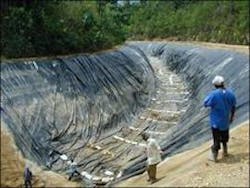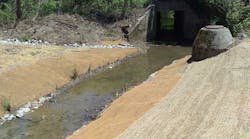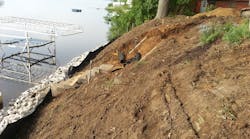Geosynthetics are amazing products. They range from sheets that are less than a millimeter thick to three-dimensional cells. They may be pervious or impervious, woven, knitted, stitched, matted, or extruded.
Made of polymer materials such as polyolefin, polypropylene, high-density polyethylene (HDPE), and low-density polyethylene (LDPE), they’re thinner, lighter, and easier to install than sand, gravel, and clay. They have higher resistance to stress, but they’re more sensitive to ultraviolet light. For this reason, they are commonly UV-stabilized.
Geosynthetics serve five different functions: separation, reinforcement, filtration, drainage, and confinement. Their uses range from reducing soil erosion and containing stormwater to reinforcing retaining walls and lining ponds. When they’re combined with natural materials such as gravel, or soil and vegetation, they may be decorative as well.
Geosynthetics are amazing products. They range from sheets that are less than a millimeter thick to three-dimensional cells. They may be pervious or impervious, woven, knitted, stitched, matted, or extruded. Made of polymer materials such as polyolefin, polypropylene, high-density polyethylene (HDPE), and low-density polyethylene (LDPE), they’re thinner, lighter, and easier to install than sand, gravel, and clay. They have higher resistance to stress, but they’re more sensitive to ultraviolet light. For this reason, they are commonly UV-stabilized. Geosynthetics serve five different functions: separation, reinforcement, filtration, drainage, and confinement. Their uses range from reducing soil erosion and containing stormwater to reinforcing retaining walls and lining ponds. When they’re combined with natural materials such as gravel, or soil and vegetation, they may be decorative as well. [text_ad] There are eight main categories of geosynthetics. Each category may serve more than one function, and two or more categories may be used together. Geotextiles are made of polypropylene fibers that are either woven (which includes knitted and stitched) or nonwoven. They serve at least one of the five functions, and often more than one at a time. Nonwoven geotextiles are matted together and have a random three-dimensional structure. They’re highly permeable. They may be used to drain green roofs, as well as to separate subsoils from gravel and to filter water, for example, behind retaining walls, and in dams, canals, and reservoirs. Woven geotextiles are much less permeable than nonwoven ones. They are used primarily to stabilize soil and to separate subsoils from gravel or paved surfaces. They may have a secondary function for filtration. Geogrids are made of polymers formed into open, gridlike configurations by stretching, by weaving or knitting, or by laser or ultrasonic bonding. They may be composed of two or three layers, which are designed to confine a fill material such as crushed aggregate. Uniaxial geogrids have strength in a single direction. They are used primarily to stabilize steep slopes, or in retaining and mechanically stabilized earth (MSE) walls and embankments. Biaxial geogrids have strength in two directions. They are used most often to stabilize soil and paved and unpaved roadways.There are eight main categories of geosynthetics. Each category may serve more than one function, and two or more categories may be used together.
Geotextiles are made of polypropylene fibers that are either woven (which includes knitted and stitched) or nonwoven. They serve at least one of the five functions, and often more than one at a time.
Nonwoven geotextiles are matted together and have a random three-dimensional structure. They’re highly permeable. They may be used to drain green roofs, as well as to separate subsoils from gravel and to filter water, for example, behind retaining walls, and in dams, canals, and reservoirs.
Woven geotextiles are much less permeable than nonwoven ones. They are used primarily to stabilize soil and to separate subsoils from gravel or paved surfaces. They may have a secondary function for filtration.
Geogrids are made of polymers formed into open, gridlike configurations by stretching, by weaving or knitting, or by laser or ultrasonic bonding. They may be composed of two or three layers, which are designed to confine a fill material such as crushed aggregate.
Uniaxial geogrids have strength in a single direction. They are used primarily to stabilize steep slopes, or in retaining and mechanically stabilized earth (MSE) walls and embankments.
Biaxial geogrids have strength in two directions. They are used most often to stabilize soil and paved and unpaved roadways.
Geocells, or cellular confinement systems, are extruded from polymers into strips that are welded together ultrasonically. The strips are expanded to form a three-dimensional cellular network that is relatively thick and durable as well as flexible and lightweight. The cells may be filled with compacted soil, gravel, or concrete.
The systems perform many functions, often more than one per application. They reduce soil erosion, provide drainage, distribute loads over a wider area, reinforce slopes and road bases, and provide stable surfaces for walking or driving.
Geosynthetic clay liners are a combination of two geotextiles and bentonite clay. The clay is rolled into thin layers and encased between the geotextiles. All three layers are needle punched or stitched together. The clay liners are used to contain water in tunnels, dams, canals, and ponds.
Geomembranes are thin, flexible, impervious sheets of either HDPE or linear low-density polyethylene (LLDPE). They are used primarily to contain water in dams, canals, and ponds; as liners in tunnels; and in green roofs to separate plant roots from the roof of the structure.
Geonets and geospacers are made of polymers that are extruded into netlike configurations. The network forms a sheet that can carry relatively large flows of liquids or gas. They may be three-dimensional. They serve primarily as drainage in conjunction with other geosynthetics such as geocomposite sheets and geotextiles. They’re used on rooftop gardens, behind retaining walls, and in dams, canals, and reservoirs. In areas where there is soil erosion, they may filter runoff to an underground basin or to a layer of rock or aggregate.
Geofoam blocks or slabs are created when polystyrene foam expands, resulting in a network of rigid, closed, gas-filled cells. Geofoam reduces vertical and lateral earth pressures on structures such as retaining walls and embankments. It also provides very lightweight void fill on structures such as highways, parking lots, and green roofs.
Geocomposites are a combination of two or more geosynthetics. They also may include soil, clay, or gravel.
The variety of possible combinations gives geocomposites the greatest variability of geosynthetic functions. They perform all five: separation, reinforcement, filtration, drainage, and containment.






